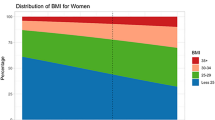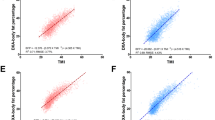Abstract
Surveillance data describing the weight status of the US population often rely on self-reported height and weight, despite likely differences in reporting accuracy by demographics. Our objective was to determine if there were racial/ethnic differences in accuracy of self-reported body mass index (BMI) in a diverse nationally representative sample of young people. Using data from Wave III (data collected in 2001–2002) of the National Longitudinal Study of Adolescent Health when respondents were aged 18–26, we used gender-stratified multivariable linear regression models to examine the association of race/ethnicity and self-reported BMI controlling for measured BMI while also adjusting for factors known to be associated with weight self-perception. Black males and females (bFemale=0.45, confidence interval (CI): 0.19, 0.71; bMale=0.34, CI: 0.17, 0.51) and Hispanic females (bFemale=0.30, CI: 0.08, 0.52) and Native American males (bNative American=0.87, CI: 0.15, 1.58) reported higher BMIs than their similarly weighted White peers, leading to more accurate BMI reporting in these groups at higher BMIs. Caution should be taken in interpreting results from studies relying on self-reported BMI, as they may exaggerate racial/ethnic differences in weight status.
This is a preview of subscription content, access via your institution
Access options
Subscribe to this journal
Receive 12 print issues and online access
$259.00 per year
only $21.58 per issue
Buy this article
- Purchase on Springer Link
- Instant access to full article PDF
Prices may be subject to local taxes which are calculated during checkout

Similar content being viewed by others
References
Wang Y, Beydoun MA . The obesity epidemic in the United States- gender, age, socioeconomic, racial/ethnic, and geographic characteristics: a systematic review and meta-regression analysis. Epidemiol Rev 2007; 29: 6–28.
Gordon-Larsen P, Adair LS, Popkin BM . The relationship of ethnicity, socioeconomic factors, and overweight in US adolescents. Obes Res 2003; 11: 121–129.
CDC Differences in prevalence of obesity among black, white, and Hispanic adults- United States, 2006–2008. MMWR Morb Mortal Wkly Rep 2009; 58: 740–744.
Ogden CL, Flegal KM, Carroll MD, Johnson CL . Prevalence and trends in overweight among US children and adolescents, 1999–2000. JAMA 2002; 288: 1728–1732.
Strauss RS . Comparison of measured and self-reported weight and height in a cross-sectional sample of young adolescents. Int J Obes Relat Metab Disord 1999; 23: 904–908.
Brener ND, McManus T, Galuska DA, Lowry R, Wechsler H . Reliability and validity of self-reported height and weight among high school students. J Adolesc Health 2003; 32: 281–287.
Morrissey SL, Whetstone LM, Cummings DM, Owen LJ . Comparison of self-reported and measured height and weight in eighth-grade students. J Sch Health 2006; 76: 512–515.
Gillum RF, Sempos CT . Ethnic variation in validity of classification of overweight and obesity using self-reported weight and height in American women and men: the Third National Health and Nutrition Examination Survey. Nutr J 2005; 4: 27.
Wen M, Kowaleski-Jones L . Sex and ethnic differences in validity of self-reported adult height, weight and body mass index. Ethn Dis 2012; 22: 72–78.
Johnson WD, Bouchard C, Newton Jr RL, Ryan DH, Katzmarzyk PT . Ethnic differences in self-reported and measured obesity. Obesity (Silver Spring) 2009; 17: 571–577.
Radloff LS . The CES-D scale: a self-report depression scale for research in the general population. Appl Psychol Meas 1977; 1: 385–401.
Brener ND, Kann L, Kinchen SA, Grunbaum J, Whalen L, Eaton D et al. Methodology of the youth risk behavior surveillance system. MMWR Recomm Rep 2004; 53: 1–13.
Centers for Disease Control and Prevention. Behavioral risk factor surveillance system. Available at http://www.cdc.gov/brfss (accessed 14 April 2014).
Acknowledgements
We are grateful for the help of Grace Kennedy in preparing the figure. Tracy Richmond is funded by the NIH Career Development award (NICHD K01 HD058042).
Author information
Authors and Affiliations
Corresponding author
Ethics declarations
Competing interests
The authors declare no conflict of interest.
Additional information
Supplementary Information accompanies this paper on International Journal of Obesity website
Supplementary information
Rights and permissions
About this article
Cite this article
Richmond, T., Thurston, I., Sonneville, K. et al. Racial/ethnic differences in accuracy of body mass index reporting in a diverse cohort of young adults. Int J Obes 39, 546–548 (2015). https://doi.org/10.1038/ijo.2014.147
Received:
Revised:
Accepted:
Published:
Issue Date:
DOI: https://doi.org/10.1038/ijo.2014.147
This article is cited by
-
Cultivating Moral Attention: a Virtue-Oriented Approach to Responsible Data Science in Healthcare
Philosophy & Technology (2021)
-
Self-Compassion, Internalized Weight Stigma, Psychological Well-Being, and Eating Behaviors in Women
Mindfulness (2021)
-
Associations of socio-demographic factors with adiposity among immigrants in Norway: a secondary data analysis
BMC Public Health (2020)
-
Ethnic differences in overweight and obesity and the influence of acculturation on immigrant bodyweight: evidence from a national sample of Australian adults
BMC Public Health (2016)
-
Young Adults’ Attitudes and Perceptions of Obesity and Weight Management: Implications for Treatment Development
Current Obesity Reports (2016)



